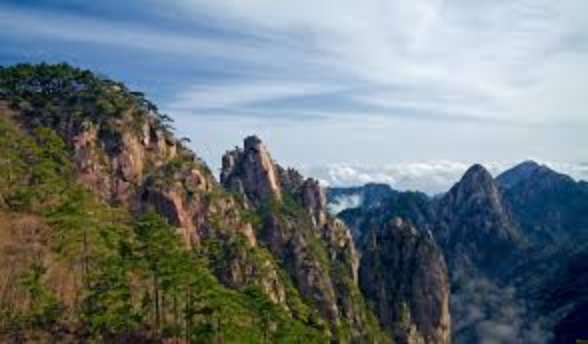
The Significance of Mount Huangshan
Mount Huangshan, often described as the “loveliest mountain of China”, has played an important role in the history of art and literature in China since the Tang Dynasty around the 8th century, when a legend dated from the year 747 described the mountain as the place of discovery of the long-sought elixir of immortality. This legend elevated the mountain's status, transforming it into a sacred space and a source of artistic inspiration for centuries to come.
Natural Splendor: A Tapestry of Unique Geological Formations and Biodiversity
Mount Huangshan is renowned for its breathtaking natural beauty, characterized by:
| Feature | Description |
|---|---|
| Peculiarly Shaped Granite Peaks | These peaks, often shrouded in mist, offer breathtaking views and have inspired countless poems and paintings. |
| Huangshan Pine Trees (Pinus hwangshanensis) | These resilient trees cling to the cliffs, their contorted shapes a testament to their struggle for survival in harsh conditions. |
| Hot Springs | Believed to have medicinal properties, these springs offer relaxation and rejuvenation amidst stunning natural scenery. |
| Sea of Clouds | This ethereal phenomenon, where clouds appear to flow below the peaks, creates a sense of awe and otherworldly beauty. |
This unique combination of geological wonders and diverse flora has captivated artists and travelers for centuries.
Artistic Muse: Inspiring Artists Across Mediums and Dynasties
Mount Huangshan's awe-inspiring landscapes have served as a rich source of inspiration for Chinese artists across various dynasties:
- Painting: The mountain's distinctive features are prominent in the "shan shui" (mountain-water) style of painting, with notable works by masters like Shitao and Huang Binhong capturing its essence. These paintings often feature the interplay of light and mist, emphasizing the ethereal beauty and grandeur of the peaks.
- Poetry: Renowned poets like Li Bai and Du Fu have immortalized Mount Huangshan in their verses. Their poems evoke the mountain's grandeur, serenity, and mystical qualities, often comparing it to a celestial realm.
- Photography: In modern times, photographers continue to be drawn to Mount Huangshan's dramatic scenery, capturing its beauty in stunning detail. The interplay of light and shadow on the granite peaks, the ethereal beauty of the Sea of Clouds, and the resilient pines clinging to the cliffs offer endless photographic opportunities.
Spiritual Significance: A Sacred Landscape of Taoist Legend and Pilgrimage
Beyond its aesthetic appeal, Mount Huangshan holds profound spiritual significance:
- Taoism: The mountain is closely associated with Taoism, an ancient Chinese philosophy that emphasizes living in harmony with nature. The legend of the elixir of immortality further cemented its status as a sacred site.
- Pilgrimage: For centuries, pilgrims have journeyed to Mount Huangshan, seeking spiritual enlightenment amidst its tranquil surroundings. The climb to the summit is seen as a metaphorical journey towards self-discovery and connection with the divine.
- Temples and Monasteries: The mountain is home to numerous ancient temples and monasteries, some perched precariously on cliffs, serving as testaments to the enduring connection between spirituality and nature.
Modern Significance: A UNESCO World Heritage Site and Tourist Destination
Today, Mount Huangshan holds immense significance as:
- UNESCO World Heritage Site: It was designated as a World Heritage Site in 1990, recognizing its "exceptional natural beauty" and "cultural importance." This designation helps protect the mountain's ecosystem and cultural heritage for future generations.
- Major Tourist Destination: Millions of tourists visit Mount Huangshan annually, drawn by its breathtaking scenery, cultural attractions, and opportunities for hiking and outdoor recreation. The area boasts well-developed infrastructure, including cable cars, hotels, and restaurants, catering to a range of visitor needs.
FAQs
- Q: What is the best time to visit Mount Huangshan?
- A: Spring and autumn are considered the best times, offering pleasant weather, clear skies, and vibrant foliage.
- Q: How long does it take to climb Mount Huangshan?
- A: The average climbing time is 3-5 hours, depending on the chosen route and fitness level. Cable cars are available for those who prefer a shorter ascent.
- Q: What should I pack for a trip to Mount Huangshan?
- A: Comfortable hiking shoes, layered clothing, rain gear, sunscreen, a hat, sunglasses, a reusable water bottle, and a camera are essential items.